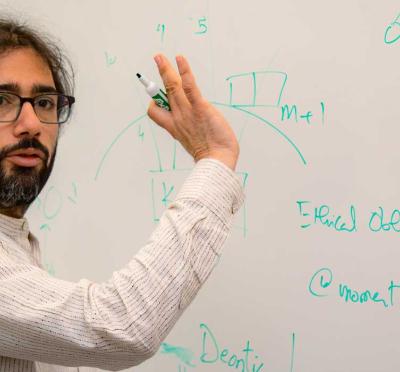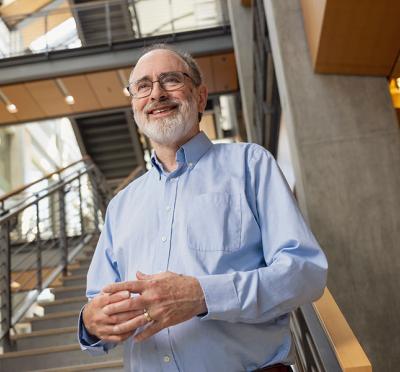Oregon State University’s College of Engineering is the nation’s seventh-largest engineering college and a proven leader in research, with impacts that extend statewide, regionally, nationally, and globally. Research conducted here expands knowledge and creates use-inspired solutions in fields such as artificial intelligence, robotics, advanced manufacturing, clean water, materials science, sustainable energy, high-performance computing, resilient infrastructure, and health-related engineering.
In the 2022-2023 fiscal year, the College of Engineering received more than $85.3 million in sponsored research awards, its highest total ever and an increase of nearly 13% over the previous record of $75.8 million, set the previous year. With 326 new and continuing awards from 143 sponsors, 148 faculty members have been chosen as lead principal investigators. Funding sources include the National Science Foundation, the Office of Naval Research, the U.S. Department of Energy, the Oregon Department of Transportation, and the Oregon Health Authority. The following is an overview of notable grants received in the last fiscal year.
Christopher Daly, research professor in the School of Chemical, Biological, and Environmental Engineering and founding director of Oregon State’s PRISM Climate Group, aims to strengthen the nation’s crop insurance underwriting and oversight activities using PRISM spatial weather data sets. The project is funded by a $4.8 million grant from the U.S. Department of Agriculture’s Risk Management Agency. Crop insurance programs cover more than $120 billion in crop value and protect farmers against losses from weather events and other natural hazards. PRISM’s high-resolution quality spatial weather maps and data, along with expert interpretation, will allow the agency to determine risk more accurately, improve underwriting capability, substantiate weather events, and better assess the validity of claims. Daly anticipates another $1.75 million agreement with the RMA that will expand the group’s work to Hawaii, Alaska, and Puerto Rico. Funding has topped $30 million over the project’s 11 years so far.
A team led by Jason Weiss, the Miles Lowell and Margaret Watt Edwards Distinguished Chair in Engineering, is developing a cellulose cement composite, or C3, that will be a durable, fire-resistant, low-carbon alternative to dimensional lumber and sheet products (such as plywood and drywall) used in residential and light commercial construction. The project is funded by a $2.5 million grant from the U.S Department of Energy. The new C3 will have high insulation values, resist rot and fungal growth, and be compatible with current construction processes. It will be made from low-value, small-diameter trees that are unsuitable for lumber production, thereby reducing a source of fuel that exacerbates wildfires. The material also holds the potential to mitigate supply chain and material cost volatility associated with lumber. The researchers plan to provide a parallel development track focused on bringing the technology to the market.
Ted Brekken, professor of electrical and computer engineering, is investigating the augmentation of standard hydroelectric generation units with fast-acting energy storage to create a hybrid hydroelectric-storage generation unit. Funded by a $2.4 million grant from the U.S. Department of Energy, the researchers will construct a 200-kilowatt lab-based hybrid hydroelectric generation unit that will serve as a testbed for performance analysis and model validation. The project’s goal is to demonstrate and quantify the value provided by a hybrid hydroelectric-storage generation unit and ultimately improve hydropower’s ability to integrate variable renewable resources and quickly adapt to yearly and seasonal changes in system loads.
To support the continuing development of components for TerraPower’s sodium fast reactor, Wade Marcum, the Henry W. and Janice J. Schuette Professor in Nuclear Science and Engineering, is leading a team of researchers investigating the potential effects of sodium on properties, such as friction and wear, of structural materials and coatings. Liquid sodium serves as the reactor’s coolant. The work is funded by a $1.7 million from a DOE grant awarded to TerraPower, a nuclear reactor design and development engineering company, though the original source of the award is the DOE. The researchers will perform tests in low-oxygen liquid sodium metal for friction performance, wear resistance, and resistance to self-welding when under contact for extended periods in sodium.
Geoff Hollinger, associate professor of mechanical engineering and robotics and the Ron and Judy Adams Faculty Scholar, is leading a team of researchers in creating novel bio-inspired soft, reconfigurable swimming robots. The design was inspired by salps, marine organisms whose bodies consist of long chains of jet pumps that they use to control their shape, position, and motion. The research team, funded by a $5.3 million grant from the Office of Naval Research, envisions a system of multiple heterogeneous soft robots made of advanced polymers formed by 3D printers into complex geometries. The robots will have the potential to inspect and monitor environments such as shipwrecks, underwater infrastructure, littoral zones, caves, and reefs, in challenging conditions. The team will also focus on distributed coordination and control of large numbers of salplike underwater robots.
Pallavi Dhagat, professor of electrical and computer engineering, is heading up the creation of a Regional Innovation Engine to advance semiconductor technologies in the Pacific Northwest. The work is funded by a $1 million NSF grant. The goal is to develop an innovation ecosystem that will: advance use-inspired semiconductors, invent scalable nanofabrication manufacturing processes that can be leveraged across multiple platforms, develop innovative computational tools for predicting material properties that will enable unforeseen applications, expand innovation and entrepreneurship through regional programs and partnerships, and create training programs to enable a diverse workforce for regional industry needs, thereby creating a more secure and prosperous future for the state, regional, and national economies. Working closely with diversity, equity, inclusion, and access partners across Oregon, Washington, and Idaho, this project will expand its impact to increase underrepresented minority participation in STEM degree programs and professional careers.
Xue Jin, assistant professor of environmental engineering, is developing a novel electrodialysis-forward osmosis process that will concurrently recover soil nutrients and clean water from anaerobically pre-treated wastewater. The nutrient-rich stream can be used for direct fertigation—delivering nutrients to crops through irrigation systems. The research team, funded by a $750,000 grant from the U.S. Department of Agriculture, is addressing the critical need for effective treatment technologies that provide safe, reclaimed water for agricultural irrigation by creating a method that can be used to facilitate sustainable, resource-intensive farming, which depends on sustainable sources of water and nutrients that cannot be met by existing freshwater supplies.
Thomas Dietterich, emeritus Distinguished Professor of Computer Science, was awarded a $424,000 grant from the Defense Advanced Research Projects Agency to advance, develop, and test the theory, architectures, and algorithms for novelty-aware computer vision. Current computer vision systems apply deep learning to a large body of image data based on the false assumption that the world is unchanging, and the system will not encounter variations that aren’t present in the training data. To solve the problem, the research team applied a method based on the premise that deep novelty detection works by detecting the absence of familiar image features rather than the presence of novelty. An important engineering goal is to develop a single novelty-aware computer vision system that can be easily configured for many different application scenarios.



